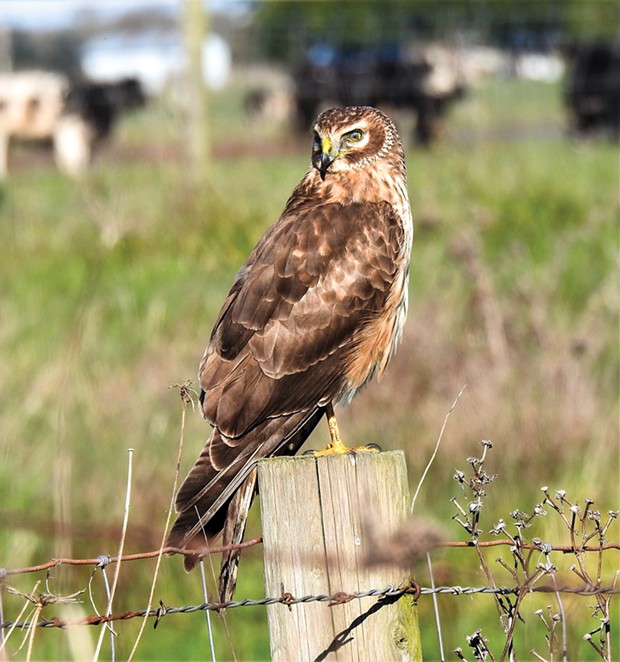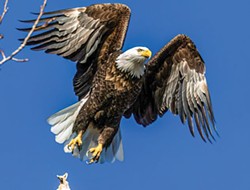[
{
"name": "Top Stories Video Pair",
"insertPoint": "7",
"component": "17087298",
"parentWrapperClass": "fdn-ads-inline-content-block",
"requiredCountToDisplay": "1"
}
]
While we're caught up in the daily grind here on the ground, there's a lot of great birding happening above our heads.
That's where the big birds fly: the eagles, hawks and vultures that quicken the pulse of birders and nonbirders alike because of their sheer bulk and massive wingspans. However, conditions are seldom ideal for an accurate identification of those dark blobs in the sky. Sometimes all we can say is ... it's a bird.
But with practice it's possible to distinguish many, if not most, of the birds circling above us. Birds of prey, or raptors, tend to flap and soar more slowly, giving us an opportunity to observe their wingspan, flight style and even some of the dark and light patterns of their feathers. Here are some key field marks to watch for that can help distinguish the members of this fascinating bird family quickly — before they sail over the horizon and disappear.
Turkey vulture. When your first impression is of a majestic, soaring eagle, your bird is usually a turkey vulture. Not that turkey vultures aren't majestic in their own right; they're pretty spectacular birds, with a wingspan of about 65 inches and special adaptations that make them well-suited to life on the cleanup crew. Turkey vultures have keen vision and an exceptional sense of smell. In fact, the area of the brain that processes odors is larger in vultures than in other birds, enabling them to sniff out carrion from up to a mile away.
An excellent field mark for a turkey vulture is the pronounced "V" shape of its wing position as it soars, helping it ride the thermals like a surfer at Moonstone. From underneath, those wings appear two-toned, dark at the shoulders and gray along the trailing feathers, and the bird's naked head — pink in adults, gray in youngsters — seems tiny due to its lack of feathers. They're common throughout the county.
Bald eagle. It may not have been Ben Franklin's choice for our national bird, but a bald eagle is always a thrill to see. Young birds don't get the unmistakable white head and tail of the adults until they're 5 or so years old, but eagles of any age have a huge wingspan of around 80 inches, and soar with their wings in a flat line as opposed the "V" of a turkey vulture. Eagles also have big heavy bills that help separate them from red-tailed hawks and ospreys, even in flight.
Winter is a good time to see bald eagles around the county, especially near water where they'll prey on fish — or harass other fish-eating birds like ospreys into giving up their catch.
Osprey. Ospreys are very cool birds and one of the easier raptors to identify, even from a distance. White below and dark above, an osprey has long narrow wings with a telltale crook at the "elbow." Its head is white with a black stripe through the eye like a bandit, and its strongly hooked bill is perfectly designed for fishing.
Because they live almost exclusively on fish, you won't often find ospreys far from water. They make spectacular feet-first dives into the drink, then fly off with their prey to disembowel it at their leisure.
Red-tailed hawk. One of the most common hawks in Humboldt and across the U.S., the red-tailed hawk belongs to the buteo family, big chunky hawks with broad wings and relatively short tails. That red tail should make this bird easy to identify, right? Well, not always. Chances are the lighting, the bird's age or its particular subspecies will make that field mark unreliable. Young red-tails don't have a red tail at all — their tails are barred. A more consistent field mark is a band of dark color across the belly of the hawk, known as (naturally) the belly band.
And just to make things more challenging, red-tails come in multiple color combos or "morphs" — my Stokes field guide devotes five pages to variations on a single species, with names like "Harlan's" or "Krider's." They're still red-tailed hawks.
By the way, a common raven is as big as a red-tailed hawk and can easily be mistaken for one, especially in poor light. If your all-dark bird has a distinctly wedge-shaped tail and flaps in a circular motion like it's rowing a boat, it's probably a raven.
Red-shouldered hawk. This striking buteo can often be seen along the road, perched on telephone poles or even balanced on the wires. Its characteristic hunched posture always reminds me of my mom saying, "Sit up straight!" The "red" shoulders aren't always easy to see and young birds don't have them at all, but all ages have a checkered pattern on the wings. In flight, look for that dark-and-light wing pattern and for an almost translucent crescent-shaped mark near the tip of each wing.
Northern harrier. Harriers float over dunes and grasslands much the way vultures soar on thermals, their wings held in a similar but more shallow "V" shape. These hawks are long-winged and long-tailed; up close, you might be able to see their disc-shaped faces that give them an owlish look. Like owls, harriers use their sharp hearing to locate prey in the flora below them.
The male harrier is gray above and white below with black wingtips, and the female is rusty brown with checkered wings. In flight, look for their white rump patches, an excellent field mark.
There are, of course, a few other large, dark birds that might catch your eye as they fly overhead. Geese are big and dark-bodied but tend to fly in noisy flocks, like the thousands of Aleutian cackling geese that recently descended on the county. Cormorants, chunky diving birds common in Humboldt Bay, fly with rapid wingbeats and outstretched necks. A great blue heron is a huge dark bird with an impressive 7-foot wingspan, but it has a long neck folded into an "S" shape and its feet extend past its tail in flight.
So, if you spot something with big wings relative to a small head, think bird of prey — and then see if you can pick out a few field marks and narrow it down to species. And if it's massive, with a wingspan of nearly 10 feet, who knows? It just might be a California condor. That day is coming, so why not dream big?
Sarah Hobart (she/her) is a freelance writer based in Humboldt County.
more from the author
-
A Chime of Wrens
- Apr 11, 2024
-
Bird Names for Everyone
- Feb 29, 2024
-
Spark Birds
- Jan 11, 2024
- More »
Latest in Get Out
Readers also liked…
-
A Walk Among the Spotted Owls
- Apr 27, 2023

































